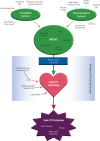Cardiovascular effects of metabolic syndrome after transplantation: convergence of obesity and transplant-related factors
- PMID: 29423213
- PMCID: PMC5798023
- DOI: 10.1093/ckj/sfx056
Cardiovascular effects of metabolic syndrome after transplantation: convergence of obesity and transplant-related factors
Abstract
Children are at increased risk of developing metabolic syndrome (MS) after kidney transplantation, which contributes to long-term cardiovascular (CV) morbidities and decline in allograft function. While MS in the general population occurs due to excess caloric intake and physical inactivity, additional chronic kidney disease and transplant-related factors contribute to the development of MS in transplant recipients. Despite its significant health consequences, the interplay of the individual components in CV morbidity in pediatric transplant recipients is not well understood. Additionally, the optimal methods to detect early CV dysfunction are not well defined in this unique population. The quest to establish clear guidelines for diagnosis is further complicated by genetic differences among ethnic groups that necessitate the development of race-specific criteria, particularly with regard to individuals of African descent who carry the apolipoprotein L1 variant. In children, since major CV events are rare and traditional echocardiographic measures of systolic function, such as ejection fraction, are typically well preserved, the presence of CV disease often goes undetected in the early stages. Recently, new noninvasive imaging techniques have become available that offer the opportunity for early detection. Carotid intima-media thickness and impaired myocardial strain detected by speckle tracking echocardiography or cardiac magnetic resonance are emerging as early and sensitive markers of subclinical CV dysfunction. These highly sensitive tools may offer the opportunity to elucidate subtle CV effects of MS in children after transplantation. Current knowledge and future directions are explored in this review.
Keywords: dyslipidemia; echocardiography; ethnicity; hypertension; nutrition; pediatrics.
Figures
Similar articles
-
Effects of obesity and metabolic syndrome on cardiovascular outcomes in pediatric kidney transplant recipients: a longitudinal study.Pediatr Nephrol. 2018 Aug;33(8):1419-1428. doi: 10.1007/s00467-017-3860-8. Epub 2017 Dec 30. Pediatr Nephrol. 2018. PMID: 29290033
-
Comparison of BMI, waist circumference, and waist-to-height ratio for identification of subclinical cardiovascular risk in pediatric kidney transplant recipients.Pediatr Transplant. 2018 Dec;22(8):e13300. doi: 10.1111/petr.13300. Epub 2018 Oct 7. Pediatr Transplant. 2018. PMID: 30294896
-
Metabolic syndrome, insulin resistance, and chronic allograft dysfunction.Kidney Int Suppl. 2010 Dec;(119):S42-6. doi: 10.1038/ki.2010.422. Kidney Int Suppl. 2010. PMID: 21116317 Review.
-
European Association of Cardiovascular Imaging/Cardiovascular Imaging Department of the Brazilian Society of Cardiology recommendations for the use of cardiac imaging to assess and follow patients after heart transplantation.Eur Heart J Cardiovasc Imaging. 2015 Sep;16(9):919-48. doi: 10.1093/ehjci/jev139. Epub 2015 Jul 2. Eur Heart J Cardiovasc Imaging. 2015. PMID: 26139361 Review.
-
Speckle tracking echocardiography as a new diagnostic tool for an assessment of cardiovascular disease in rheumatic patients.Prog Cardiovasc Dis. 2020 May-Jun;63(3):327-340. doi: 10.1016/j.pcad.2020.03.005. Epub 2020 Mar 20. Prog Cardiovasc Dis. 2020. PMID: 32201285 Review.
Cited by
-
Obesity and metabolic syndrome in a diverse pediatric kidney transplant population: which anthropometric measure best predicts arterial stiffness?Pediatr Nephrol. 2025 Jul;40(7):2363-2373. doi: 10.1007/s00467-024-06635-8. Epub 2025 Jan 14. Pediatr Nephrol. 2025. PMID: 39808333
-
The new Clinical Kidney Journal, 4 years later.Clin Kidney J. 2019 Feb;12(1):1-5. doi: 10.1093/ckj/sfy139. Epub 2019 Feb 5. Clin Kidney J. 2019. PMID: 30746126 Free PMC article.
-
Assessment and management of obesity and metabolic syndrome in children with CKD stages 2-5 on dialysis and after kidney transplantation-clinical practice recommendations from the Pediatric Renal Nutrition Taskforce.Pediatr Nephrol. 2022 Jan;37(1):1-20. doi: 10.1007/s00467-021-05148-y. Epub 2021 Aug 10. Pediatr Nephrol. 2022. PMID: 34374836 Free PMC article. Review.
-
Effects of obesity and metabolic syndrome on cardiovascular outcomes in pediatric kidney transplant recipients: a longitudinal study.Pediatr Nephrol. 2018 Aug;33(8):1419-1428. doi: 10.1007/s00467-017-3860-8. Epub 2017 Dec 30. Pediatr Nephrol. 2018. PMID: 29290033
-
Longitudinal follow-up on vascular morphology and function in children with kidney transplants.Acta Paediatr. 2023 Mar;112(3):557-568. doi: 10.1111/apa.16646. Epub 2023 Jan 12. Acta Paediatr. 2023. PMID: 36567640 Free PMC article.
References
-
- Dharnidharka VR, Fiorina P, Harmon WE.. Kidney transplantation in children. N Engl J Med 2014; 371: 549–558 - PubMed
-
- Brady TM, Parekh RS.. Metabolic syndrome: signs and symptoms running together. Pediatr Transplant 2010; 14: 6–9 - PubMed
-
- McGill HC, Jr, McMahan CA, Herderick EE, et al.Origin of atherosclerosis in childhood and adolescence. Am J Clin Nutr 2000; 72(Suppl 5): 1307S–1315S - PubMed
-
- Berenson GS, Srinivasan SR, Bao W, et al.Association between multiple cardiovascular risk factors and atherosclerosis in children and young adults. The Bogalusa Heart Study. N Engl J Med 1998; 338: 1650–1656 - PubMed
-
- Grundy SM, Cleeman JI, Daniels SR, et al.Diagnosis and management of the metabolic syndrome: an American Heart Association/National Heart, Lung, and Blood Institute Scientific Statement. Circulation 2005; 112: 2735–2752 - PubMed
LinkOut - more resources
Full Text Sources
Other Literature Sources


